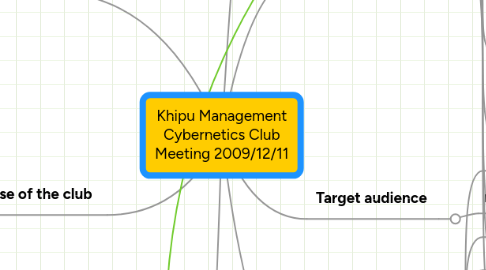
1. Next steps
1.1. Platform
1.1.1. infoco.ru
1.1.1.1. Open system
1.1.2. Mailing list
1.1.2.1. [email protected]
1.1.3. Community
1.1.3.1. http://community.livejournal.com/vsmclub
1.2. Brief course for newbies (with examination)
1.2.1. Cybernetics
1.2.2. VSM
1.3. Library collection
1.3.1. Glossary
1.3.2. Web links
1.3.2.1. Comments
1.4. Directions by priority
1.4.1. #1 Standarts of system design
1.4.1.1. Glossary
1.4.1.2. Formal notation
1.4.2. #2 Practical implementation methods
1.4.2.1. Motivation
1.4.2.2. Supervision
2. Information base of the club
2.1. Glossary
2.2. Distance learning environment
2.3. Library
2.3.1. Basic works
2.3.2. Adapted writings
2.3.3. Criticism
2.3.4. Positive cases
2.4. Programs and algorithms repository
2.5. Wiki
2.6. Client program to remotely partiсipate in club meetings
3. Khipu ERP (opensource VSM-based)
3.1. Why "Khipu"?
3.1.1. Quipu record keeping was/had…
3.1.1.1. Сomprehensive realtime management & governance system
3.1.1.2. Data generalization bottom-up
3.1.1.3. Three vectors of productivity (!!!)
3.1.1.4. Double record accounting
3.1.2. The name shouldn't be faceless, there should be a mistery behind
3.1.2.1. Continuity with Tawantinsuyu and Chile
3.2. Standards development
3.3. Methodology
3.4. VSM notation for business processes
3.5. Adoption of existing opensource components
3.6. Methodology of interpersonal communications
3.7. Editing tool to describe subject areas
3.8. Steps
3.8.1. Building from bottom to up
3.8.1.1. #1 First-degree recursion (from person to primary group)
3.8.1.2. #2 Further recursion (group→workshop→plant→…)
4. Club goals
4.1. VSM as a society refactoring tool
4.2. Solving of a problem of big systems management
4.3. Practical applying of the common theory of systems
4.4. VSM will be a base of governance to come
4.5. Creating a methodology to make social sciences positive (in epistemological meaning)
4.6. Commercialization
5. Practical applyings
5.1. ERP
5.1.1. Decision support system
5.1.1.1. Personal situation center
5.1.2. Realtime integration of all management and control systems (nervous system of the enterprise)
5.1.2.1. MRP
5.1.2.2. CRM, B2B
5.1.2.3. accounting & budjeting
5.1.2.4. HR
5.1.2.5. warehouse
5.1.2.5.1. logistics
5.1.2.6. stock exchange monitoring
5.1.2.7. workflow automation
5.1.2.8. intelligent building
5.1.2.9. security&emergency systems
5.1.2.9.1. access control
5.1.2.9.2. Sensors (e.g. fire alarm) as alhedonic
5.1.2.10. street traffic data
5.1.2.11. etc…
5.2. Organization diagnostics
5.2.1. Software
5.2.2. Methodics
5.3. Viable systems growing
5.3.1. Startups support
5.4. Cases for diverse activity branches
5.4.1. Factories
5.4.1.1. VSM applying to mass production (A.Zakharov)
5.4.2. Trade
5.4.3. Opensource software companies
5.4.4. Local governments
5.5. Consulting
5.5.1. Pilot project: Linux Center rearrangement
5.5.1.1. Long-term viability
5.6. Tools to design non-commercial communities
5.6.1. Consumer's co-operation
5.7. Outsourcing
5.7.1. Separate blocks of management
5.7.2. Consulting
5.7.3. Information disposal
6. Target audience
6.1. Managers who have understood that the management theory was hidden from them
7. VSM advantages
7.1. Variety control tools
7.1.1. Autonomy
7.1.1.1. Resource agreement
7.1.2. Recursion
7.1.3. Black box
7.2. Triple vector of performance
7.3. Minimization of bureaucracy
7.4. Oriented to changes
7.4.1. Balance between current activity and development
7.5. Realtime management
7.5.1. Efficient reaction to environment changes
7.5.2. Alhedonic signals
7.6. Balance between formal organization and decentralization
7.7. Situational center
7.7.1. Environment monitoring
7.7.2. Modelling
7.7.2.1. Environment
7.7.2.2. System reaction
7.7.3. Forecasting
7.7.4. Scenarios directory
7.7.5. Alhedony
